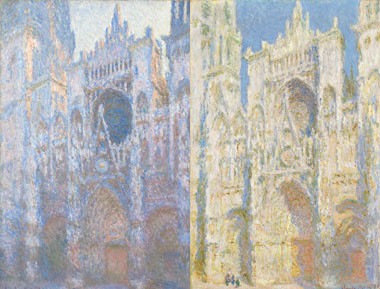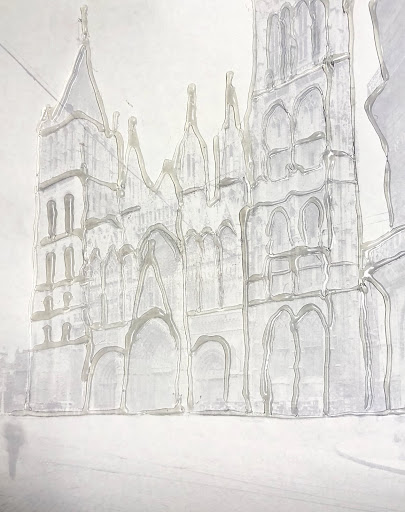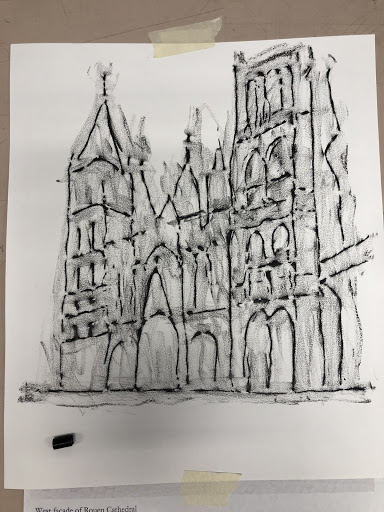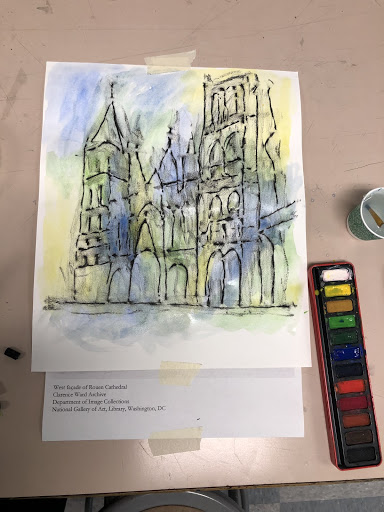Color Theory Color Is an Element of Art Worksheet Answers
The Elements of Fine art: Colour
Grade Level: 1–two
Students will be introduced to one of the basic elements of fine art—colour—through analysis of works of fine art by Monet, Matisse, and Kandinsky. Class word focused on these paintings will assist students understand how artists use color to convey atmosphere and mood. They volition then examination their color expertise by completing a downloadable worksheet and coloring a photograph of Rouen Cathedral.

Left:
Claude Monet
French, 1840–1926
Rouen Cathedral, West Façade, 1894
oil on canvass, 100.1 x 65.9 cm (39 3/8 x 25 15/16 in.)
National Gallery of Art, Chester Dale Collection
Correct:
Claude Monet
French, 1840–1926
Rouen Cathedral, Due west Façade, Sunlight, 1894
oil on canvass, 100.1 x 65.eight cm (39 iii/viii x 25 7/8 in.) National Gallery of Fine art, Chester Dale Drove
Curriculum Connections
- Science
- Language Arts
Materials
- Smart Board or estimator with ability to projection images from slideshow
- Writing materials
- Oil pastels or crayons
- Copies of the "Colorful Language" worksheet and faded image of Rouen Cathedral
- Hot glue
- 11 10 xiv paper
- Watercolors and brushes
Warm-up Questions
Are these paintings of the same building? How are they similar and different?
Background
Color is what we run into considering of reflected light. Light contains dissimilar wavelengths of energy that our eyes and brain "encounter" as different colors. When light hits an object, nosotros see the colored light that reflects off the object.
Red, blueish, and xanthous are the master colors. With paints of just these 3 colors, artists can mix them to create all the other colors. When artists mix pigments of the primary colors, they make secondary colors.
Crimson + Blue = Imperial
Ruby + Xanthous = Orange
Blue + Yellowish = Green
Did you know that your calculator screen also works by using iii primary colors? But here, since the colors are low-cal from the monitor and not paints, the three primaries are non the same. Instead, your figurer screen mixes other colors from cerise, blue, and green.
One of import thing painters know: using complementary colors—the ones across from each other on the colour wheel (red-greenish, blue-orange, and yellow-imperial)—make both colors seem brighter and more than intense. They seem to vibrate and pop out at y'all, the viewer.
Warm colors—reds, yellows, oranges, and red-violets—are those of fire and the sun. They appear to project. Cool colors—blues, blueish-greens, and blueish-violets—are those of ice and the ocean. They appear to recede.
Guided Exercise
To get students thinking almost color and the moods or feelings that colors tin can convey, read a book that focuses on colour, such as The Day the Crayons Quit past Drew Daywalt.
Then view the slideshow below to introduce students to three artists—Claude Monet, Henri Matisse, and Wassily Kandinsky—and the manner they used color in their paintings.
Slideshow: Monet, Matisse, and Kandinsky on Colour
French artist Claude Monet liked to pigment the same subject area over and over over again, at different times of day and in different types of atmospheric condition. He painted Rouen cathedral in France some thirty times, but what fascinated him most was not the edifice—information technology was, he said, the surrounding atmosphere. Rather than quick studies of changing lite effects, these pictures, slowly reworked in the studio, are advisedly considered explorations of color and mood:
- Each painting uses Rouen Cathedral to record time (morning or late afternoon) and weather (sunlight or mist). Examine the way Monet used color and texture: Can you tell from the shadows in the doorways which painting might have been washed in the morning and which in the afternoon? (Don't forget that the lord's day rises in the east and these paintings bear witness the west façade or front of the building.) How do the colors change in sunlight, fog, and mist?
- Do y'all see any clear outlines? Is information technology possible to determine exactly where 1 surface ends and another begins? If line does not define the forms in this painting, what does? (Answer: color!)
Around 1905 several artists, including Matisse, exhibited pictures in which heightened color was used to express a stiff emotional response to nature. The painters were chosen "fauves," or wild beasts. The freshness and strength of the tones in Open up Window, Collioure are typical of the fauves; Matisse's contrasts are subtle, giving this work a sense of tranquility and radiance. Prove students this painting (second to last prototype in the slideshow) to answer the following questions:
- Would y'all rather become sailing or stay in your absurd room admiring the view?
- Describe the colors. How are they different from what you come across in nature? What color would y'all usually use to colour the sea? Have you ever seen a pink ocean? (Peradventure if it's reflecting a dusk…)
- How big do y'all think this painting is? It's actually just 21 3/4 x 18 1/8 inches. Run into how Matisse transformed the event of a pocket-sized sheet into expansive pictorial infinite through the device of the open window and eye-popping color.
Wassily Kandinsky, raised in Odessa, Russian federation, learned to play the cello and pianoforte equally a child. As an artist, he drew connections between art and music and believed that colors and shapes could touch on our mood. Show students Improvisation 31 (Ocean Battle) (last epitome in the slideshow) without revealing the name of the title:
- What colors do you see in this painting? What do the colors in this painting make y'all feel? happy? distressing? scared?
- What practise you think is happening in this painting?
- Afterwards students have hypothesized what the scene depicts, allow them know the title contains the phrase "ocean battle." Now have them clarify the painting: Tin can y'all find two tall-masted ships locked in gainsay? Tin can they spot any catechism fire? What is the sea like that day? The conditions?
Activity
Download a faded version of the photograph of the west façade of Rouen Cathedral in Paris that Monet painted at all time of day and in all types of weather (the original photograph is the start image in the slideshow). Students will select a time of twenty-four hour period and type of weather and then color over this faded paradigm using appropriate hues in oil pastel (preferable to cover image, but crayons could as well be used).
As an alternative that can conform students with visual impairments, print out a larger version of the images on eleven x 14 paper. Trace the lines of each image with hot mucilage to create a raised surface that students can feel. Then give students a evidently piece of newspaper to lay over the image outlined in hot glue. Students can then create a texture rubbing with crayon over the newspaper. Equally a last step the students can paint over the crayon rubbing with watercolors.

On a printed version of the epitome, trace the lines with hot mucilage to create a raised surface that students can experience.
Extension
Now that students take investigated diverse uses of color in three artists' works, they will fill up out the "Colorful Language" worksheet to examination their knowledge of colour. Next, students will select one work of fine art from the slideshow as if information technology were a postcard of somewhere they visited. They will and then write a brusque letter to a friend or family fellow member describing what they saw, what fourth dimension of day it was, and what the atmospheric condition was similar using the colors from the work of art equally their guide.
The Elements of Art is supported by the Robert Lehman Foundation
National Core Arts Standards
VA:Cr2.1.one Explore uses of materials and tools to create works of art or design.
VA:Cr2.2.iDemonstrate safe and proper procedures for using materials, tools, and equipment while making art.
VA:Cr3.1.i Utilize art vocabulary to describe choices while creating art.
VA:Re7.1.2 Perceive and describe aesthetic characteristics of 1'due south natural world and constructed environments.
VA:Re7.2.one Compare images that stand for the same discipline.
VA:Re8.ane.ii Interpret fine art by identifying the mood suggested by a work of art and describing relevant subject affair and characteristics of class.
VA:Re9.i.2 Use learned art vocabulary to express preferences about artwork.
fockenanthery1943.blogspot.com
Source: https://www.nga.gov/learn/teachers/lessons-activities/elements-of-art/color.html














0 Response to "Color Theory Color Is an Element of Art Worksheet Answers"
Post a Comment